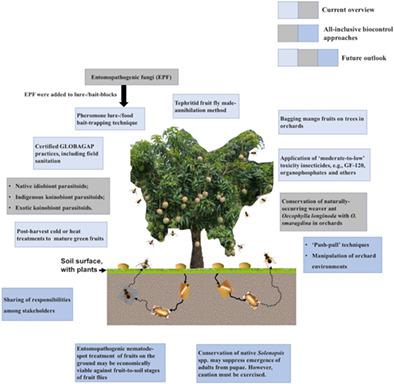当前位置:
X-MOL 学术
›
Pest Manag. Sci.
›
论文详情
Our official English website, www.x-mol.net, welcomes your
feedback! (Note: you will need to create a separate account there.)
Overview and future research needs for development of effective biocontrol strategies for management of Bactrocera dorsalis Hendel (Diptera: Tephritidae) in sub-Saharan Africa
Pest Management Science ( IF 3.8 ) Pub Date : 2021-05-25 , DOI: 10.1002/ps.6485 William K Heve 1 , Thomas A Adjadeh 2 , Maxwell K Billah 3
Pest Management Science ( IF 3.8 ) Pub Date : 2021-05-25 , DOI: 10.1002/ps.6485 William K Heve 1 , Thomas A Adjadeh 2 , Maxwell K Billah 3
Affiliation

|
Infestation of fruits by native and invasive fruit flies causes significant economic losses. In most cases, incidence of ‘regulated’ dangerous fruit flies in orchards results in restrictions on export of fruits from such places to international markets. Unfortunately, use of insecticides applied on foliage and fruits does not kill the fruit-to-soil stages of fruit flies. However, diverse biological control agents (BCAs) do so. Thus, prevalence of native and invasive fruit flies in orchards will require that a combination of BCAs is included in integrated pest management (IPM) programmes. In the case of Bactrocera dorsalis Hendel and other economically important fruit flies found in sub-Saharan Africa (SSA), use of classical biocontrol approach involves concomitant releases of two exotic parasitoids (Fopius arisanus Sonan and Diachasmimorpha longicaudata Ashmead). These non-native wasps may have complemented the indigenous parasitoids in combination with application of entomopathogenic fungi (EPFs) and conservation of predatory ants (Oecophylla longinoda Latreille, with O. smaragdina) in fruit fly IPM plans. Consequently, some levels of decline in fruit infestation have been observed. Although interspecific interactions between BCAs against several insect pests have produced varying results, including threatening the survival of other BCAs, the prevalence of B. dorsalis in orchards across SSA requires further research to investigate effects of coalescing biocontrol approaches in IPM strategies. Therefore, future research into combining parasitoids, EPFs and entomopathogenic nematodes, in addition to conservation of predatory ants (O. longinoda, O. smaragdina and others) in IPM plans may improve the effectiveness of currently used strategies for the management of fruit-infesting tephritids. © 2021 Society of Chemical Industry.
中文翻译:

在撒哈拉以南非洲制定有效的生物防治策略以管理 Bactrocera dorsalis Hendel(双翅目:Tephritidae)的概述和未来研究需求
本地和外来果蝇侵染水果会造成重大经济损失。在大多数情况下,果园中“受管制”的危险果蝇的发生导致限制从这些地方向国际市场出口水果。不幸的是,在叶子和果实上使用杀虫剂并不能杀死果蝇从果实到土壤的阶段。然而,不同的生物控制剂 (BCA) 会这样做。因此,果蝇本地和入侵果蝇的流行需要将 BCA 的组合纳入虫害综合管理 (IPM) 计划中。对于在撒哈拉以南非洲 (SSA) 发现的Bactrocera dorsalis Hendel 和其他经济上重要的果蝇,使用经典的生物防治方法涉及同时释放两种外来寄生蜂。Fopius arisanus Sonan 和Diachasmimorpha longicaudata Ashmead)。在果蝇 IPM 计划中,这些非本地黄蜂可能与昆虫病原真菌 (EPF) 的应用和捕食性蚂蚁 ( Oecophylla longinoda Latreille, with O. smaragdina ) 的保护相结合,对本地寄生蜂起到了补充作用。因此,已观察到果实侵染程度有所下降。尽管 BCA 对几种害虫的种间相互作用产生了不同的结果,包括威胁其他 BCA 的生存,但B. dorsalis的流行在整个 SSA 的果园中,需要进一步研究以研究联合生物防治方法在 IPM 策略中的效果。因此,除了在 IPM 计划中保护捕食性蚂蚁(O. longinoda、O. smaragdina等)之外,未来对结合寄生蜂、EPF 和昆虫病原线虫的研究可能会提高目前用于管理水果侵染性节肢动物的策略的有效性. © 2021 化学工业协会。
更新日期:2021-05-25
中文翻译:

在撒哈拉以南非洲制定有效的生物防治策略以管理 Bactrocera dorsalis Hendel(双翅目:Tephritidae)的概述和未来研究需求
本地和外来果蝇侵染水果会造成重大经济损失。在大多数情况下,果园中“受管制”的危险果蝇的发生导致限制从这些地方向国际市场出口水果。不幸的是,在叶子和果实上使用杀虫剂并不能杀死果蝇从果实到土壤的阶段。然而,不同的生物控制剂 (BCA) 会这样做。因此,果蝇本地和入侵果蝇的流行需要将 BCA 的组合纳入虫害综合管理 (IPM) 计划中。对于在撒哈拉以南非洲 (SSA) 发现的Bactrocera dorsalis Hendel 和其他经济上重要的果蝇,使用经典的生物防治方法涉及同时释放两种外来寄生蜂。Fopius arisanus Sonan 和Diachasmimorpha longicaudata Ashmead)。在果蝇 IPM 计划中,这些非本地黄蜂可能与昆虫病原真菌 (EPF) 的应用和捕食性蚂蚁 ( Oecophylla longinoda Latreille, with O. smaragdina ) 的保护相结合,对本地寄生蜂起到了补充作用。因此,已观察到果实侵染程度有所下降。尽管 BCA 对几种害虫的种间相互作用产生了不同的结果,包括威胁其他 BCA 的生存,但B. dorsalis的流行在整个 SSA 的果园中,需要进一步研究以研究联合生物防治方法在 IPM 策略中的效果。因此,除了在 IPM 计划中保护捕食性蚂蚁(O. longinoda、O. smaragdina等)之外,未来对结合寄生蜂、EPF 和昆虫病原线虫的研究可能会提高目前用于管理水果侵染性节肢动物的策略的有效性. © 2021 化学工业协会。










































 京公网安备 11010802027423号
京公网安备 11010802027423号